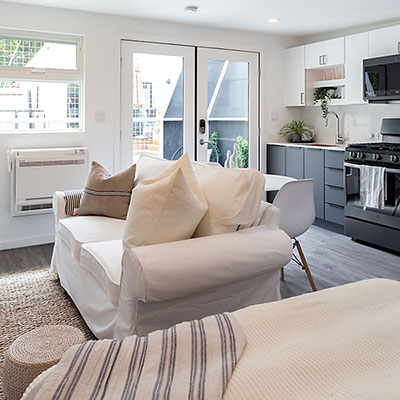Sept. 9, 2021
While increasing housing density can address scarcity and affordability issues, it often faces political hurdles, particularly in suburban and rural areas. But one measure is steadily gaining acceptance in communities of all sizes: accessory dwelling units (ADUs), or residential structures on the same property as detached single-family homes.
Over the past 20 years, hundreds of cities and counties — if not more — have embraced ADUs, says David Morley, AICP, a planner and research manager at the American Planning Association. States have passed their own legislation, too, including California and Oregon in the past few years.
That momentum has held through the pandemic, as unemployment and uncertainty around eviction moratoriums have made the existing housing crisis even more dire. Sarasota, Florida, approved new legislation in July, as did Barnstable, Massachusetts, the tenth Cape Cod town to adopt an ADU bylaw. Lexington, Kentucky, and Kalispell, Montana, near Glacier National Park, are currently considering their own.
"So many jurisdictions across the country devote more land area to single-family detached housing than any other land use," Morley says. That means plenty of backyards that could offer a new home. And in many places, homeowners are making it happen. Los Angeles, the epicenter of the nation's ADU push, saw permits increase from 71 in 2014 to 6,747 in 2019, two years after California's statewide legislation went into effect.
But laws alone can't kick-start an ADU boom. Local preemption, high costs, and regulatory issues are just some of the hurdles that need to be cleared to encourage construction.
Uneven successes
California is one of the most significant examples of what happens when a government allows ADUs, Morley says. Following statewide legislation, the number of ADU permits issued increased from 1,269 in 2016 to 14,702 in 2019. A year later, five more bills were passed to further incentivize ADUs and reduce barriers. Despite the pandemic, 12,392 permits were issued in 2020.

The increase in ADU permits California cities issued from 2016, the year before pro-ADU legislation was passed at the state level, to 2019.
Source: California Dept. of Housing & Community development.; buildinganadu.
LA isn't the only city where construction has skyrocketed; San Jose and Oakland each saw a nine-fold or higher increase in permits between 2016 and 2020. At the same time, however, Malibu, Coronado, and other cities have enacted onerous requirements for homeowners or taken more than the mandated 60 days to review applications.
And on the other side of the country, Vermont's most populous city, Burlington, has seen few ADU permit requests: one to eight per year. The state passed regulations making ADUs legal in 2005, but homeowners continue to report financial, zoning, and regulatory snags.
The state of Vermont was frank about these impediments in its 2020 ADU checklist. "The permits and steps all have important functions," it reads, "but, taken as a whole, can make the process difficult, expensive, or even impossible."
Building ADUs is a more complicated process than laws alone acknowledge, confirms Ahmad Abu-Khalaf, a planner and senior research analyst on the policy development and research team at nonprofit Enterprise Community Partners. His 2020 report on barriers to ADU development identifies a variety of regulatory and financial issues. For homeowners, that can include identifying a financing source, securing a construction team, and acting as a landlord.
If cities want to meet affordability targets for ADU owners, he says, they need to get more involved. Most people tap into personal savings or home equity to finance construction, a challenge for lower- and moderate-income households. To "democratize" construction, Abu-Khalaf calls for the creation of lending products that are not only tailored to ADU development, but also accessible to lower- and moderate-income households. Governments can also offer subsidies to develop homes that are affordable for households making 30 percent or 50 percent of the area median income.
"It's not a process that will happen in an organic way," Abu-Khalaf says. "There should be more intentional efforts by policymakers or multiple nonprofits." He calls for lending products that are tailored to ADU development and accessible to lower- and moderate-income households. He points to the nonprofit LA Más, which helped lower-income homeowners build ADUs they agreed to rent to housing-voucher holders for at least the first five years.
In addition to looking at minimum lot size, height, parking, and other regulatory requirements, Abu-Khalaf says planners can work with local housing finance or affordable housing departments to design financial programs for lower- and moderate-income households interested in building ADUs.
Still, ADUs are not a cure-all for the affordability crisis, experts say; they're part of a larger housing agenda. Morley says planners can play a role in facilitating conversations as communities consider whether they provide housing choice at affordable levels for everyone.
"If the answer is no, and frankly the answer is no in a lot of places, then it's about considering what are our alternatives for increasing the supply of housing, for increasing the diversity of types of housing that are available in the community," he says. "Accessory dwelling units are often one of the easiest strategies to build agreement on."




